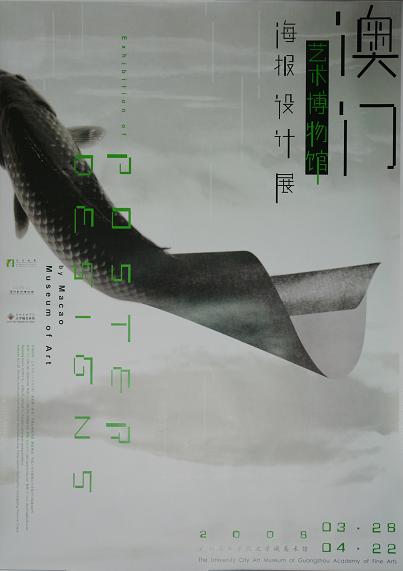
展览名称:澳门艺术博物馆海报设计展
主办:澳门艺术博物馆、广州美术学院大学城美术馆
展览日期:2008年3月28日至4月22日
开放时间:上午十时至下午六时,逢星期一休馆,节假日照常开放
展览地点:中国广州市番禺区大学城外环西路168号广州美术学院大学城美术馆
展厅:5、6号展厅
十六世纪中叶,葡萄牙商船开始陆续在澳门靠岸,从那时起,极具特色的异国文化正式在这个南中国小城中散播开来。多年来,葡萄牙、马来西亚及日本等外来文化与本地文化经历长时间的磨合,对此间的生活习惯、饮食文化,以至日常语言等运用方面都产生了深刻的影响。同一时间,西方的科学、艺术、宗教、文化都不断通过澳门输入中国内地;中国丰富的物产乃至哲学思想等亦从澳门传往欧洲。中西文化交流,在澳门拉开了序幕。
但到了十九世纪中叶鸦片战争后,澳门的国际贸易港地位逐渐被香港取代,文化中转站的角色从此淡出。但是,澳门并未因而终止了自身文化的滋长。一九一零年,澳门成立了第一所博物院──贾梅士博物院,亦即是澳门艺术博物馆前身。到了三十年代,该馆在社会热心人士的关怀下取得了很大的发展,其艺术藏品亦日益丰富。在七十年代,馆方以拓阔本地艺术家的视野为目标,除了展出自身收藏,还开设画廊,并积极邀请外来及本地艺术家举办展览,以期建立起艺术交流的平台,使艺术家在观摩及学习中不断成长。
一九九九年,即澳门回归祖国怀抱同一年的三月十九日,澳门艺术博物馆正式对外开放。这是一个崭新的文化设施空间及举办大型展览的重要场地,从开馆至今举办了逾百项各类型展览及活动。这些项目的合作者包括北京故宫博物院、上海博物馆、南京博物院、河南省博物馆等内地大型文博机构、及来自香港、台湾、法国、葡萄牙、意大利、捷克、芬兰、西班牙、美国、墨西哥、哥伦比亚、埃及、新西兰等国家、地区的博物馆及艺术家、收藏家等,这些展览中既有清代皇家收藏的珍贵文物,也有如陈淳、徐渭、董其昌、八大、石涛,扬州八怪或近代的吴昌硕、张大千、傅抱石等代表中国传统文化精萃的作品,而西方艺坛举足轻重的毕加索、米罗、雷诺阿、尼基、克莱茵、阿曼等重要艺术家的作品也曾在此展出。在中西文化交流的舞台上,澳门艺术博物馆扮演着一个重要的角色。
一个展览活动的成功与否,除本身的素质外,宣传形象的确立也极为重要,宣传海报的设计是否突显每一项目的特性?出版物能否吸引大众的视线且引起广泛关注?这些都是主办机构的重要考虑内容。我馆拥有由一群青年设计师组成的精干团队,他们因应不同的项目,以艺术及文化的角度出发,尝试打破常规,以期取得独特的效果。在画面上,从用色、字体配合以至版面设计上的变化,都力求从原本传统刻板的内容中引发出现代感的视觉元素。作为一个多元文化汇聚的小城,我馆在海报创作上不能避免地面对着不同种族的语种问题,如中文、葡萄牙文及英文甚至法文、西班牙文、意大利文等,常常需要同时出现在同一张海报上。然而,通过别出心裁的安排,此等限制却反而成为艺博馆在设计上的一大特色。二零零四年本馆受芬兰拉特海报博物馆及赫尔辛基海报美术馆的邀请展出本馆部分海报创作。二零零六年至二零零七年间,我馆创作的多款海报先后在捷克布尔诺“第二十二届平面设计双年展”主展场及皮尔森吉瑞.特兰卡展览馆展出。
今天,澳门民政总署辖下澳门艺术博物馆十分荣幸与广州美术学院大学城美术馆合作,向广州市民介绍这些宣传海报,这里展出的一百幅作品,大部分出自本馆平面设计师之手,借着这些风格各异的海报,观众不但可以欣赏到设计师们的独特艺术创作,也可以与我们一起分享并重温澳门艺术博物馆开幕至今所举办的精彩展览及活动,见证本馆的成长之路。
吴卫鸣
澳门艺术博物馆馆长
In the middle of the 16th Century, Portuguese merchant ships started to anchor off Macao. Since that time, an exotic culture has taken root in this tiny southern Chinese city. Over the years, foreign cultures - Portuguese, Malaysian and Japanese to name but a few - have coalesced with each other, profoundly influencing the lifestyle, diet and even daily use of language in the city. At the same time, Western science, art, religion and culture have been imported to China via Macao, while rich Chinese products and even philosophical concepts have travelled to Europe from the city. The cultural exchange between East and West largely has its origins in Macao.
Following the Opium War in the mid-19th Century, Macao was overtaken by Hong Kong as an international trade port. Consequently, the city started to withdraw from its role as a centre of ‘cultural transfer’. Nevertheless, local culture has not stopped developing. The Luis de Camões Museum – the first in the city and a predecessor to the Macao Museum of Art - was founded in 1910. In the 1930s, the museum developed significantly thanks to the devotion of various passionately enthusiastic individuals in local society. The collections acquired increased at a steady rate and in the 1970s the museum sought to broaden the exposure of local artists by founding a gallery in addition to displaying collections. The museum has also encouraged foreign and local artists to hold exhibitions in order to build a strong base for exchange between artists, providing rooms for them to continuously improve by viewing and learning from each other’s works.
On 19th March 1999, the year that Macao was returned to China, the Macao Museum of Art officially opened its doors to the public - a brand new cultural facility and an important venue for large exhibitions – since when it has hosted over 100 various exhibitions and activities. Event collaboration has involved many leading art museums from Mainland China such as the Palace Museum in Beijing, Shanghai Museum, Nanjing Museum and Henan Provincial Museum as well as museums, artists and collectors from Hong Kong, Taiwan, France, Portugal, Italy, the Czech Republic, Finland, Spain, U.S.A., Mexico, Columbia, Egypt and New Zealand. Exhibits include precious relics from the Imperial Court of the Qing Dynasty and masterpieces representing the very essence of Chinese tradition and culture, such as the works of Chen Chun, Xu Wei, Dong Qichang, Ba Da, Shi Tao and the Eight Eccentric Painters of Yangzhou plus Wu Changshuo, Zhang Daqian and Fu Baoshi in more recent times. In addition, MAM has exhibited masterworks by prominent artists such as Pablo Picasso, a giant in the lexicon of Western art, Joan Miro, Pierre-Auguste Renoir, Niki de Saint Phalle, Yves Klein and Arman. As such, Macao Museum of Art is playing an important role in cultural exchange between East and West.
Apart from quality, the success of an exhibition depends on the image it is projecting and whether the design of the promotional poster highlights the features of the event or publications attract readers whose attention and interest is sufficiently aroused. These are important considerations for organisers. We have an excellent team of young designers who create posters for all events with great artistic flair and who constantly strive to free themselves from convention in order to create a unique impact. They strive to introduce modern visual elements into traditional, formulaic content by employing variations in such elements as colour and font style and size.
Macao is a city of various integrated cultures and it is therefore inevitable that we sometimes face problems concerning the language of different ethnic groups when designing our posters. For example, Chinese, Portuguese, English and even French, Spanish and Italian often have to appear on one poster. Nevertheless, ingenious designs bring unique solutions to what at first glance appears to be restrictive. In 2004, we were invited by Lahti Posters Museum and Helsinki Posters Gallery to exhibit. During 2006 and 2007, many of our creations were displayed in two cities in the Czech Republic, with venues including the main exhibition hall of the 22nd International Biennale of Graphic Design Brno 2006 and Juri Trnka Gallery in Pilsen.
Macao Museum of Art managed by the Civic and Municipal Affairs Bureau is honoured to work with The University City Art Museum of Guangzhou Academy of Fine Arts to introduce these posters to the citizens of Guangzhou. The 100-plus exhibits have been created by our own graphic designers. By viewing these posters - with their individual characteristics - viewers can enjoy the unique art creations of the designers and review the exciting exhibitions and events that the Macao Museum of Art has hosted since its opening. In sharing those experiences with us, they will bear witness to the increasing success and growing maturity of Macao Museum of Art.
UNG VAI MENG
Director, Macao Museum of Art
,
|

